Day 2 ran into Day 3 because Mark got up four times in the night due to some silly stomach upset. At 6 a.m. we dragged our sleepy selves to the dining cabin in search of Imodium, which is something we always take with us on our travels . . . until this trip. We found Curt and Bobby in the dining cabin sipping coffee and they immediately offered Mark some of their Imodium. As an extra precaution, I added a roll of toilet paper to the camera lenses in my dry bag. And as a final precaution, I made two cheese sandwiches and avoided any meat.
We headed upstream to a really twisty, narrow area that required a lot of maneuvering by Prato to get through.
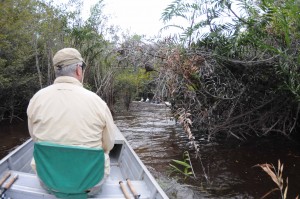
In this narrow stretch we saw our first freshwater stingray. Some stingrays have spots and some do not and Mark asked me to keep my eyes out for a stingray so that he could videotape one underwater. Now, being the supportive spouse that I am, I stood to go to the front of the boat . . . just as Prato kicked the motor into gear. I fell backwards and smacked my elbow. Prato stopped the boat and waited patiently while I dumped bottled water on my bloody elbow. I sat down in great embarrassment and we motored on. Prato is the one that showed Mark a stingray that was captured on video. Hm.
About an hour later, we came to a larger stretch of stream where Prato said “We fish.” So we did. Mark soon reeled in a jacunda, which we learned later isn’t caught real often–Bibi has only caught 4 in the 13 years she’s fished the Amazon tribs.
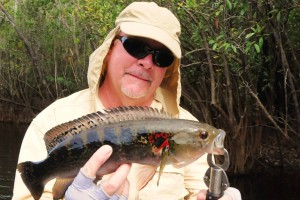
Of course, jacundas don’t count for anything, so we continued fishing. I’d been flogging the water for a while before I caught a peacock bass so small it’s barely worth mentioning. In fact, the morning was so slow I started doubting whether I had what it takes for this trip. I missed a few smacks on my lure. Later, I got an arowana.
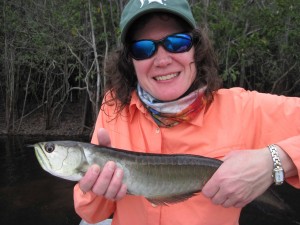
The arowana is a pretty nifty fish if you ask me because in a river with so many toothy fish, what’s this one doing?
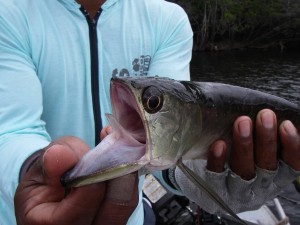
By mid-morning Mark had a small butterfly peacock. An hour or so later Mark caught a barred peacock, but one that still didn’t register in the 8-pound range. It looked nice, though.
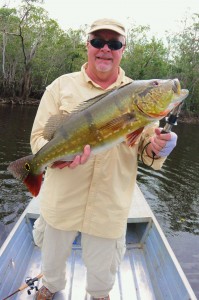
Shortly after Mark caught that fish, I had to remove some of the water I’d accumulated in my bladder, so Mark asked Prato if we could pull off at the nearest sandbar. I had several criteria for a good spot to take a leak in the Amazon: out of view of the guide, out of reach of snakes, caiman and bees, and within Mark’s hearing range. As I was about to duck behind I tree, I looked back to make sure Prato couldn’t see me . . . and saw him taking a leak off the back of the boat. It’s so unfair.
We continued fishing and after lunch—which we ate in the boat—I caught my first spotted peacock using a black and red surface bait called a High Roller. The fish was, of course, less than 8 pounds. Mark also caught a black piranha which is a nifty toothy thing that we photographed up close.
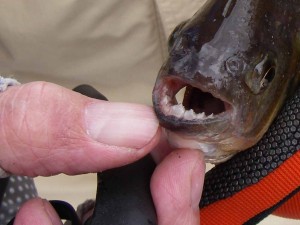
While Mark added a few more dog fish and wolf fish to his list of uncounted catches, I took time out for a few bird photos. This is a lesser razor-billed curassow. What makes him lesser than more-er is beyond me.
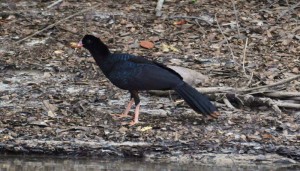
I also saw this bird.

This hawk let us get really close. I like that it’s a plumbeous hawk because plumbeous isn’t a word I use most days. And does one even pronounce the “b” in plumbeous, because we don’t pronounce the “b” in plumber?
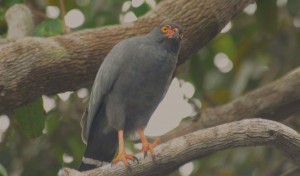
And then there were these two really attractive birds.
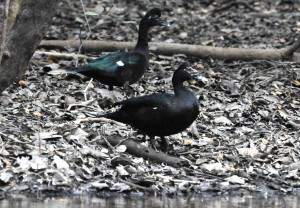
Way up in a tree, I saw this bird.

We returned to camp with a mere 10 peacock bass under our belt, which, for those keeping track, was two better than yesterday but still pretty pathetic. Our total, 18, was the lowest in camp.
We showered, got something to drink, and while chatting with the other fishermen, learned that they had all been to the Amazon fishing before with one exception–the youngest of the French men. Bobby showed us a photograph on his phone of peacock bass he caught on one trip–it weighted over 20 pounds. (He also showed us a photo of a rattlesnake on his ranch that was really impressive, too). Bobby shared that he spends most of his time ripping lures across the water; Curt rips and uses jigs. While we were picking up these tips, one of the French guys brought Mark the empty box from one of the lures he uses, which are made by Yo-zuri.
As Mark and I walked back to our cabin–with our flashlight in hand this time–I felt inspired and encouraged by all the guys. They’d shared their secrets; now all we had to do is crank it up a notch. I waved goodnight to Mark and we both slept really well, thanks to the Imodium.